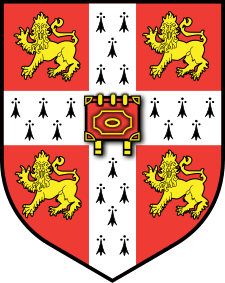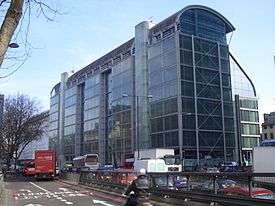Gurdon Institute
The Gurdon Institute (officially the Wellcome/Cancer Research UK Gurdon Institute) is a research facility at the University of Cambridge, specialising in developmental biology and cancer biology[4]. The Institute was founded in 1989 to provide a rich, collaborative environment for scientists working in diverse but complementary specialities in the fields of developmental biology and cancer biology. It receives its primary funding from the Wellcome Trust and Cancer Research UK.[5]
| Established | 1989 |
|---|---|
| Director | Julie Ahringer |
| Faculty | 17 |
| Key people |
|
| Location | , |
| Address | Tennis Court Road, Cambridge CB2 1QN |
| Website | www |
In 2004 it was renamed in honour of John Gurdon, joint winner of the 2012 Nobel Prize for medicine[6][7]. As of 2019 the director is Julie Ahringer and the deputy director is Eric Miska[8][9][10].
Faculty
As of 2020 there are 15 Group Leaders and 2 Associate Group Leaders.[11]
Group Leaders:
- Julie Ahringer
- Andrea Brand[12]
- Jenny Gallop[13]
- John Gurdon
- Steve Jackson
- Tony Kouzarides
- Hansong Ma
- Eric Miska[8]
- Emma Rawlins
- Ben Simons
- Daniel St Johnston
- Azim Surani
- Iva Tchasovnikarova (beginning Summer 2020)
- Fengzhu Xiong
- Philip Zegerman
Associate Group Leaders:
- Martin Hemberg
- John Perry
Alumni
Former Group Leaders:
- Michael Akam
- Enrique Amaya
- Nick Brown
- Rafael Carazo Salas
- Thomas Down
- Martin Evans
- Charles ffrench-Constant
- Janet Heasman
- Meritxell Huch
- Ron Laskey
- Rick Livesey
- Anne McLaren
- Masanori Mishima
- Nancy Papalopulu
- Eugenia Piddini
- Jonathon Pines
- Jordan Raff
- Jim Smith
- Chris Wylie
- Magdalena Zernicka-Goetz
References
- "GURDON, Sir John (Bertrand)". Who's Who. 2015 (online Oxford University Press ed.). A & C Black, an imprint of Bloomsbury Publishing plc. (subscription or UK public library membership required) (subscription required)
- "KOUZARIDES, Prof. Tony". Who's Who. 2015 (online Oxford University Press ed.). A & C Black, an imprint of Bloomsbury Publishing plc. (subscription or UK public library membership required) (subscription required)
- "ST JOHNSTON, Prof. (Robert) Daniel". Who's Who. 2015 (online Oxford University Press ed.). A & C Black, an imprint of Bloomsbury Publishing plc. (subscription or UK public library membership required) (subscription required)
- "Gurdon Institute".
- Anon (1991). "Charities cohabit in Cambridge: New £5 million institute opens". Nature. 351 (6326): 432. doi:10.1038/351432b0.
- Gurdon, J. (2003). "John Gurdon". Current Biology. 13 (19): R759–R760. doi:10.1016/j.cub.2003.09.015. PMID 14521852.
- Williams, R. (2008). "Sir John Gurdon: Godfather of cloning". The Journal of Cell Biology. 181 (2): 178–179. doi:10.1083/jcb.1812pi. PMC 2315664. PMID 18426972.
- "MISKA, Prof. Eric Alexander". Who's Who. 2018 (online Oxford University Press ed.). A & C Black, an imprint of Bloomsbury Publishing plc. (subscription or UK public library membership required) (subscription required)
- "Contact details and key roles — The Gurdon Institute". 2019-02-22. Archived from the original on 2019-01-05.
- "Eric Miska — The Gurdon Institute". 2019-02-22. Archived from the original on 2019-02-22.
- "Research group overview — The Gurdon Institute". University of Cambridge. 2019-02-22. Archived from the original on 2019-02-22.
- "BRAND, Prof. Andrea Hilary". Who's Who. 2015 (online Oxford University Press ed.). A & C Black, an imprint of Bloomsbury Publishing plc. (subscription or UK public library membership required) (subscription required)
- McMahon, H. T.; Gallop, J. L. (2005). "Membrane curvature and mechanisms of dynamic cell membrane remodelling". Nature. 438 (7068): 590–596. doi:10.1038/nature04396. PMID 16319878.

